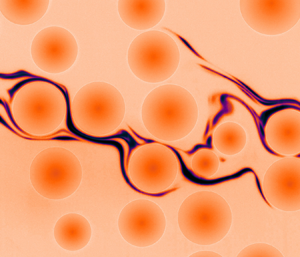Published online by Cambridge University Press: 20 April 2021

In a sheared suspension, the chaotic motion of the particles disperses the suspending liquid and drives an exponential and broadly distributed growth of the elongation of its material lines. This paper addresses experimentally and theoretically the consequences of this complex advection on the mixing of an initially segregated blob of diffusive dye, at large Péclet number and down to the finest scales of mixing. As the suspension is sheared, the combined action of the mean and fluctuating components of the flow stretches and folds the blob into a multi-scale lamellar structure. At short time, overlaps between the lamellae are scarce and the probability distribution concentration can be understood from the local stretching statistics only. At intermediate times, dispersion limits the volume within which lamellae deploy; overlaps become abundant and their statistics determine the concentration distribution. At longer times, the dye becomes homogeneous at the particle scale and the concentration distribution is set by dispersion only. Predictions for both the concentration distribution and the transitions between these successive stages of mixing are provided and compared to the experimental results.